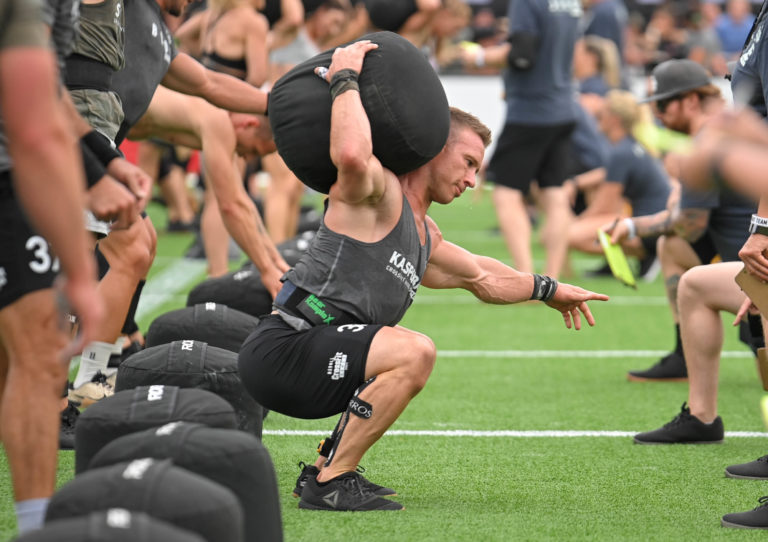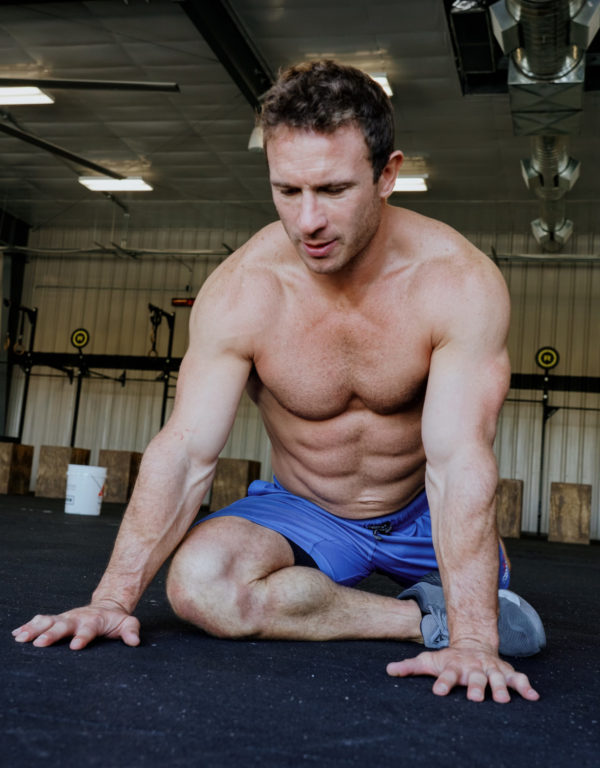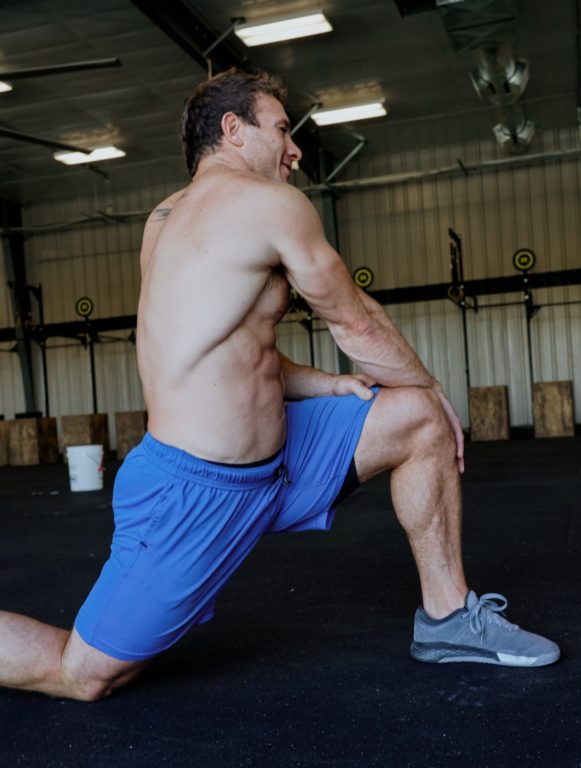
Kasperbauer takes on Event 4 at the 2021 Games after visiting the Airrosti tent for some body work (Photo by Ginnie Coleman photography).
It’s 7:00 p.m.
You’ve survived a long workday, made it to the gym, and just finished a killer workout that’s left you feeling not unlike a pile of cooked spaghetti. You peel yourself off the floor, grab your bag, and head for home and the comfort of the couch.
Right?
“If you’re sore, the last thing you want to do is go home and sit,” said Kyle Kasperbauer. “Motion is lotion.”
And Kasperbauer knows what he’s talking about. He’s been competing in CrossFit since the 2009 Games in Aromas, California, and is a four-time individual CrossFit Games athlete, two-time team Games athlete, and three-time Masters 35-39 champion. Few of his cohorts from back then remain by his side on the competition floor today.
“How have I lasted this long?” he asked. “I started this in 2009 at 27 years old, and I’m now almost 40 years old, and I feel just as fit. My body feels great, I’m enjoying life with my children … and it’s because of CrossFit.”
Because of diligent attention to a critical aspect of CrossFit, that is: recovery.
Recovery, Kasperbauer emphasized, is just as important for developing peak physical fitness as training. It’s a realization he made circa 2011, around the time he’d begun focusing exclusively on high-level CrossFit competition.
“I was reaching levels of fitness that I’d never been at; it was amazing, and I loved it,” he said.
But his body was also starting to “talk” to him, he said. His joints sometimes ached, and he had to work harder and longer to achieve full range of motion. He also discovered there were consequences to too much hard training and too little rest.

Photo courtesy of @meadowsmedia.
“So, if I’m not recovering very well throughout the week and then I really want to go to that sixth gear and really push it all the way down to the floor, I just didn’t have that,” he said.
Thus began a diligent routine focused on long and thorough warm-ups, post-workout stretching and mobility, and a greater awareness of how activities of daily life affected his body.
“Everyone always thought I was a little bit weird at first, (because) I was always showing up about 20-30 minutes before class even started,” Kasperbauer recalled, “and I would do my own warm-up. I would stretch out and smash … and then I would get taken through the (class) warm-up, and by that time, I was warm.”
Back then, he said, the extra work wasn’t imperative, just smart. Now, it’s a necessity.
These days, Kasperbauer begins a training session with 10-20 minutes of mobility work targeting whatever issues might currently be plaguing him. After that comes a 5- to 10-minute dynamic warm-up followed by accessory work, strength, and aerobic-capacity work. Post-workout comes more mobility work, stretching, and smashing.
It might sound like a lot, and that makes sense — Kasperbauer is still competing at one of the highest levels of competition in the Sport of Fitness. But a focus on recovery, he insisted, isn’t just for the sport’s top athletes. In fact, it’s perhaps even more important — from a health and longevity standpoint — for the everyday CrossFit athlete.
“Another big issue is just the fact that a ton of people will come in, do a workout, and then get in the car and go back to the office and then sit at their desk, and they’re just sitting there,” said Kasperbauer, who coaches four to five classes per week at his affiliate, CrossFit Kinesis. “And they do that five days a week. And it’s so many hours of sitting at a desk and so many hours of tightening to where all of a sudden you come back (to the gym) and you’re not even moving properly, because you haven’t spent any time in a good position.”
“It’s a difference of thriving with recovery involved in that plan or just surviving,” he added. “Eventually there’s going to be something knocking at the door, and it’s going to require your attention.”

Photo courtesy of @meadowsmedia.
There’s more to recovery than proper warm-up and mobilization. Quality and quantity of sleep, proper nutrition, and hydration all affect performance in the gym.
“I think everybody should wake up and immediately drink 20 ounces of water before anything — before their coffee, before their breakfast, before anything,” Kasperbauer said.
He also praised the benefits of omega-3, vitamin D, and magnesium supplementation, as well as dry saunas and cold showers. After all, recovery, Kasperbauer said, is just a catch-all term for “mindfully being healthy the rest of the day.”
Remember to take your rest days — and don’t be afraid to go light when your body’s telling you to, or even to substitute one movement for another altogether.
“Yeah, we all want to play on the playground and do the same thing that the other kids are doing,” Kasperbauer said. “But if you can’t do that one thing, you can do 17 other things that will be almost just as effective. And that’s the most amazing thing about CrossFit.”
Yes, it can be frustrating to modify movements or take weight off the bar.
“But I would say that it is part of the process,” Kasperbauer counseled. “Nobody’s asking (an athlete) to be the best on the whiteboard. … It’s OK to back off a little bit. Move well; be intentional. Get your brain out from the world, get it into the gym, think about the movement, think about knees out, elbows up, and just move. … And then leave better than you walked in. “
In August, Kasperbauer earned his third masters championship with three event wins and seven top-four finishes. Still, with a wife, two young children, and an affiliate to run, he says he’s now more like the “general population CrossFitters” than ever — and he says you don’t have to invest as much time into recovery as Games athletes do to reap its benefits.
Take five minutes before and after each workout to stretch and mobilize. Eat well, drink water. Take five more minutes to stretch before bedtime.
“I do it … when I’m watching a little ESPN or something right before I brush my teeth and go to bed,” Kasperbauer said. “Just being mindful, step by step, little by little.”
It’s no different than the work you do in the gym. The small efforts you put in each day pay off over time with increased fitness and improved health.
“The whole point (is) that we’re in the CrossFit gym to prevent us from being in the hospital,” he said. “And so let’s spend now versus spend later. Let’s enjoy our lives and do the things we want to do by simply just focusing on the recovery just a little bit more.”
Cover photo by Ginnie Coleman Photography.